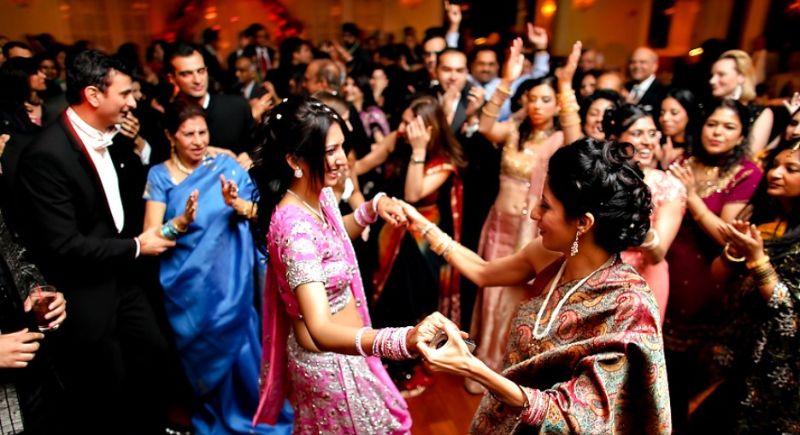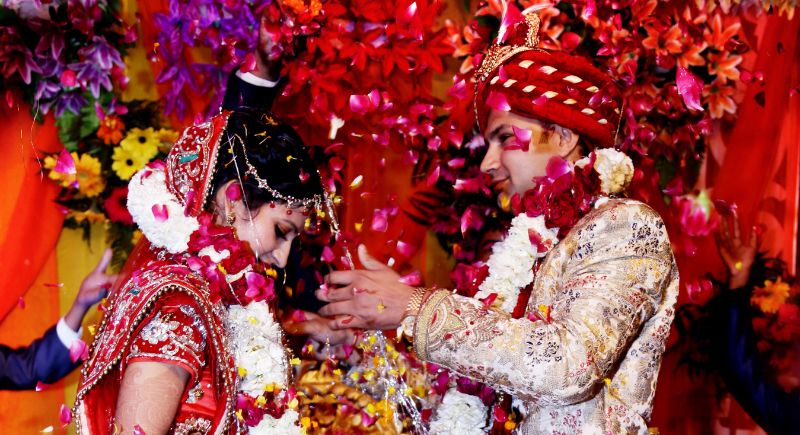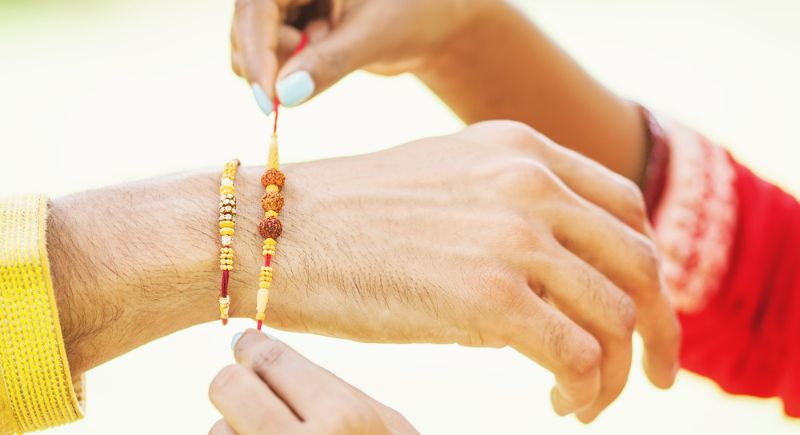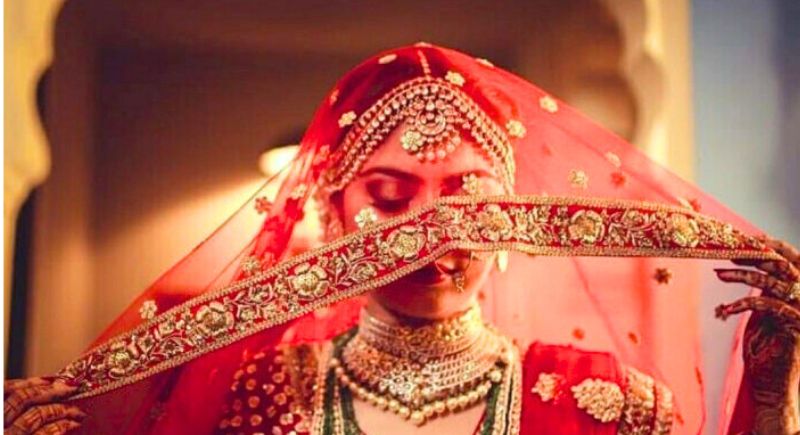Last Updated on June 23, 2024 by Ruby And The Wolf
Indian wedding traditions are nothing short of a captivating spectacle, an extraordinary fusion of culture, and celebration.
These grand ceremonies are more than just the union of two individuals; they are a tapestry of colors, rituals, and emotions that weave together the fabric of family bonds and community ties.
Steeped in history and enriched by diversity, Indian wedding traditions have stood the test of time, evolving with the changing world while retaining their deep-rooted significance.
In this exploration, we embark on a journey through the heart and soul of Indian weddings, discovering the timeless customs, vibrant ceremonies, and the unique charm that makes them a cultural treasure trove.
Join us as we unravel the rich and enchanting world of Indian wedding traditions, where love is celebrated in all its glory, and every ritual tells a story of profound meaning and enduring commitment.
1. Kanyadaan – The Giving Away of the Bride

Photo: Canva
Kanyadaan is one of the most emotional moments during an Indian wedding ceremony. It is the ritual where the bride’s parents “give away” their daughter to the groom and his family. The parents wash the groom’s feet as a sign of welcoming him into their family.
They then place the bride’s hand into the groom’s hand, symbolic of entrusting her care and protection to her new husband. This ancestral tradition emphasizes the change in roles for the bride as she leaves her childhood home to start a new life with her partner.
2. Varmala – Exchange of Garlands Between Bride and Groom

Photo: Lin & Jirsa
Another meaningful ritual during Indian weddings is varmala, the exchange of flower garlands between the bride and groom. It is typically one of the first rituals performed during the wedding ceremony. The bride and groom greet each other by placing a garland around the other’s neck.
This exchange symbolizes their acceptance of one another and willingness to enter into marriage together. It also represents a public announcement of their upcoming union. Varmala is usually a lighthearted moment, with friends and family cheering as the couple places the garlands. The exchange seals their relationship and sets the festive mood for the rest of the celebrations.
3. Sindoor Daan – Groom Applies Sindoor in Bride’s Hair Parting

Photo: Canva
Another significant ritual is sindoor daan, when the groom applies vermilion powder to the bride’s hair. With this gesture, he accepts responsibility for her care and well-being. The sindoor signifies the bride is a married woman.
Traditionally, a woman wears sindoor for her husband’s long life. The ritual marks the completion of the marriage ceremony. The groom adorns the bride by filling her hair parting with sindoor. It is an intimate moment between the couple, representing their bond.
Friends and family look on as the groom lovingly applies the sindoor. The bride will continue wearing sindoor daily as a symbol of her marital status. Sindoor daan is considered essential in Hindu weddings.
4. Mangalsutra Dharana – Tying of the Mangalsutra by Groom

Photo: Lin & Jirsa
Another key ritual is the mangalsutra dharana, when the groom ties a mangalsutra necklace around the bride’s neck. This sacred necklace signifies the bride is a married woman. Traditionally, a Hindu wife continues wearing the mangalsutra for her husband’s long life.
The black and gold mangalsutra symbolizes the couple’s marital commitment. As the groom ties the mangalsutra, family and friends look on with joy. It marks the official union of two families. The bride will proudly wear her mangalsutra every day as a marker of her married status. Mangalsutra dharana is considered an essential part of Hindu matrimony.
5. Kanya Aagaman – Bride’s Arrival at Wedding Venue

Photo: Lin & Jirsa
The kanya aagaman signals the start of the wedding festivities, as the bride makes her grand entrance at the mandap. She is welcomed by the groom’s family and friends with much fanfare. Accompanied by her parents and relatives, the bride walks down a red carpet strewn with flowers.
She is dressed in fine silk sarees and lavish gold jewelry. The assembled guests shower the bride with flower petals as she approaches the mandap. Drums and music play in celebration. The bride circles the sacred fire several times in ritual before taking her place by the groom’s side. The kanya aagaman is a joyous occasion, marking the bride’s formal arrival at her wedding. It is considered highly auspicious.
6. Antarpat – Veil Separating Bride and Groom

Photo: Anna Wu Photography
After the bride arrives at the wedding mandap, a curtain or veil known as an antarpat is held between her and the groom. This thin veil acts as a barrier separating the bride and groom before the wedding rituals take place.
The antarpat is usually held by the bride and groom’s siblings or friends. It represents the last symbolic “separation” before the two are united in marriage. Only once the wedding rituals commence will the antarpat be removed, allowing the bride and groom to see each other for the first time at the mandap.
The lowering of the veil is a special moment, representing the union of the couple. This ritual highlights the significance of the bride and groom coming together in matrimony.
7. Pheras – Circling Around the Fire

Photo: Tour My India
One of the most important Hindu wedding rituals is the pheras, or circling around the sacred fire. This ritual represents the bride and groom taking their vows of marriage. Typically, the pheras take place right after the antarpat is removed.
The bride and groom walk around the fire four to seven times, making vows to each other with each rotation. These vows promise an everlasting bond, built on trust and commitment. The fire is seen as a witness to these promises, and a provider of purification and guidance.
With each phera, the couple affirms their duties to each other and receives blessings. The pheras seal the marriage contract, marking the start of their spiritual journey together as husband and wife. This meaningful ritual is at the heart of the Indian wedding.
8. Hastamilap – Joining of Hands by Bride and Groom

Photo: Canva
After circling the sacred fire during the pheras, another significant ritual is the hastamilap. This is when the bride and groom join hands for the first time as a married couple. Their right hands are placed one on top of the other, palms touching.
The priest ties their hands together with a cloth or garland, symbolizing their union. This intimate gesture represents their commitment to walk through life hand-in-hand. The bride and groom make promises to each other to stand together in sickness and health, in good times and bad.
The hastamilap is a beautiful and emotional moment, as the couple gazes into each other’s eyes with joined hands. This ritual marks the beginning of their journey in marriage with love, trust and devotion.
9. Saptapadi – Seven Steps Taken Together

Photo: Canva
After the hastamilap, the saptapadi ceremony follows. This is a meaningful ritual where the bride and groom take seven steps together to signify the beginning of their journey as a married couple. Holding hands, they take seven steps around the sacred fire, making a vow with each step.
These seven vows represent nourishment, strength, prosperity, happiness, progeny, long life and harmony. With each step and promise made, the couple affirms their commitment to stand by each other through all of life’s ups and downs.
The number seven signifies completeness and the vows encompass all aspects of married life. Taking these steps hand-in-hand demonstrates that the bride and groom will be true companions and equals in their marriage. The saptapadi is a solemn yet joyful ceremony, bringing deep meaning to the couple’s union.
10. Vidaai – Bride’s Departure From Her Parental Home

Photo: Wedding Wire.in
After the wedding rituals conclude, the next part of the ceremony is the vidaai. This is an emotional moment, as the bride departs from her parental home to start a new life with her husband. She seeks her parents’ blessings and throws puffed rice over her head without looking back.
Her parents and siblings usually cry, sad to see her go. The groom promises to care for her and accept her as half of himself. The bride throws rice at the entrance as she leaves, a final symbolic gesture of gratitude to her parents for raising her.
She then travels to her new marital home. The vidaai marks the bride’s transition into married life. While it is a somber occasion, it also represents the beginning of an exciting new chapter. The bride looks ahead to the future, where she and the groom will build their lives together.
11. Griha Pravesh – Bride’s Arrival to Her New Home

Photo: Canva
After the emotional vidaai, the bride makes her way to her new marital home for the griha pravesh ceremony. She is welcomed by her mother-in-law with an aarti and gifts from her in-laws.
The groom’s mother performs rituals to bless and protect the bride as she crosses the threshold. She knocks over a pot of rice at the entrance, a tradition meant to signify prosperity. The bride then releases a fish into a pot, symbolizing fertility and the continuation of her husband’s family line. To enter her new home, the bride places her right foot first – another auspicious custom.
The griha pravesh marks the beginning of the bride’s new life as a married woman. She settles into her husband’s household and family. Though she may feel nervous at first, the warm welcome of the griha pravesh reassures her as she starts this next chapter.
12. Muh Dikhai – First Look At Bride’s Face by Groom’s Family

Photo: Canva
After the griha pravesh ceremony, the bride has another important ritual – the muh dikhai. Up until this point, the bride’s face has been covered by her veil. Now, the groom’s family finally gets to see the bride’s face for the first time.
The groom’s mother and aunts gather around the bride. She lowers her veil and they shower her with flower petals and gifts. This joyful ceremony welcomes the bride into the family. The women sing traditional songs to celebrate the occasion.
The mother-in-law may also feed the bride her first morsel of food in the house. With warmth and affection, they accept her as one of their own. The muh dikhai marks the official start of the bride’s role as a new daughter-in-law.
13. Pagelagni – Bride Kicks a Pot of Rice

Photo: Canva
After being welcomed into the family, the new bride takes part in a fun ritual called pagelagni. She is brought to a pot filled with rice, decorated with red vermillion and turmeric. The pot symbolizes fertility and prosperity. With her right foot, the bride tips the pot over, spilling its contents.
This act blesses her with a fruitful marriage and kicks off her new life as a married woman. The spilled rice is collected by the bridesmaids and later used to make kheer, a sweet rice pudding. Sharing this treat represents the sweet and nurturing relationship between the bride and her new family. With joy and laughter, pagelagni marks the bride’s first playful moments as a newlywed.
14. Aashirvad – Blessings for the Newlyweds

Photo: Lin & Jirsa
After the wedding rituals conclude, the bride and groom seek the blessings of elders in the family. This meaningful ceremony is called aashirvad. The couple touches the feet of their parents, grandparents, aunts and uncles. In return, the elders shower the newlyweds with love, wisdom and good wishes.
They offer them advice for a successful marriage, remind them of their duties and impart values for living virtuously. The elders often gift the couple envelopes filled with money or gold coins to financially support their new union.
Their blessings arm the bride and groom with strength and guidance to embark on their journey together. Aashirvad connects the couple to their roots and cultural heritage. By honoring family elders, they preserve time-honored traditions on their wedding day.
15. Reception Party – Celebrating With Friends and Family

Photo: Towards The Moon
After the wedding rituals wrap up, it’s time to celebrate! The reception party allows the newlyweds to share their joy with loved ones. Friends and extended family who could not attend the wedding are also invited to bless the couple and enjoy the festivities.
The reception ranges from an intimate dinner to an elaborate event with hundreds of guests. It brings together the couple’s diverse social worlds in one space to dance, toast and revel late into the night. The bride and groom make a grand entrance before cutting a gorgeous cake together.
They open up the dance floor with a romantic first dance, followed by upbeat music that gets everyone moving. Laughter and smiles abound as guests line up to embrace the newlyweds and wish them well. The reception allows the couple to relax after the intense wedding ceremonies and soak up quality time with their nearest and dearest.
16. Mehndi – Applying Henna on Bride’s Hands

Photo: Canva
Mehndi is a beloved pre-wedding tradition where intricate henna designs are applied to the bride’s hands and feet. Skilled artists use a paste made from the henna plant to draw flowery, paisley and vine motifs on the bride’s skin.
As the henna dries and is removed, it leaves behind a deep orange-brown stain for a week or two. Mehndi is believed to beautify and bless the bride while also symbolizing the deep bonds of marriage. The mehndi ceremony allows the bride to be pampered by her closest female loved ones before her world changes as a wife.
This tradition connects her to generations of Indian brides before her who also adorned their hands in henna before their weddings.
17. Sangeet – Musical Evening Before the Wedding

Photo: Google
The sangeet is a lively musical evening that takes place before the wedding. It is a chance for both families to come together to dance, sing, and celebrate the union. The bride, groom, and their friends and family perform choreographed dances and songs.
Some families even put together short humorous skits poking fun at the bride and groom. The sangeet allows everyone to let loose before the more serious marriage ceremony. It is full of music, laughter, and joy. The bride and women get dressed in colorful saris and traditional jewelry while the men don coordinated outfits.
The musical evening builds energy and anticipation for the main wedding event. The sangeet is a beloved way for families to bond and get to know each other better through shared merriment and performances.
18. Haldi – Turmeric Ceremony to Bless Bride and Groom

Photo: Potoks World Photos
The haldi ceremony is an intimate and joyful event before the wedding. It revolves around blessing the bride and groom and wishing them well as they embark on their new life together. Friends and family apply a fragrant turmeric paste to the bride and groom’s face, neck, and arms. Turmeric represents prosperity, fertility, and wisdom. The yellow color is considered auspicious.
The paste also has antiseptic properties to cleanse the skin. While the haldi is primarily for the bride and groom, their close friends and siblings also participate. They may gently tap each other with turmeric roots or grind some of the fragrant paste into each other’s hair. Laughter fills the room during this lighthearted celebration.
The haldi ceremony marks the official beginning of the wedding rituals. Once turmeric has been applied, the bride and groom are not allowed to leave the house until after the marriage ceremony, as the blessings need time to fully absorb.
19. Sehrabandi – Tying of the Groom’s Turban

Photo: Wedding Wire.in
The sehrabandi ceremony is dedicated to the groom alone. It marks his last hours as an unmarried man. The groom’s sisters and cousins tie a sehra, an ornate turban, on his head. The sehra traditionally features a long veil extending over his face, symbolizing his transition from bachelorhood to married life.
These days, short veils or brooches attached to turbans are also popular. The sister-in-law applies kajal or surma around his eyes, meant to ward off evil spirits. She may sneakily try to make his sehra lopsided or mess with his appearance! The groom wears the sehra during the baraat procession to the wedding venue.
When he arrives at the mandap to see his bride, they have a playful unveiling ritual where she tries to find his face under the veil. The sehrabandi is a lively pre-wedding tradition cherished by the groom’s family.
20. Jaimala – Garland Exchange Between Bride and Groom

Photo: Canva
The jaimala ceremony follows the milni when the bride and groom finally meet at the wedding mandap. They exchange floral garlands, symbolizing their acceptance of one another and the union of their families.
Traditionally, the bride and groom compete to be the first to garland their partner. Whoever garlands first is said to be the dominant partner in the marriage! However, many modern couples gracefully garland each other at the same time.
The jaimala is an emotionally charged moment, as the couple sees each other for the first time on their wedding day. Their garlands are linked forever, just as their destinies are joined together as husband and wife.
21. Chura Ceremony – Red and White Bangles for the Bride

Photo: Canva
After the jaimala, the chura ceremony takes place, where the bride’s maternal uncle and aunt slide ivory and red bangles onto her wrists. These chura symbolize the bride’s transition into her new life as a married woman.
The red bangles represent energy, strength and the importance of a martial bond. The ivory bangles stand for the calmness, gentleness and composure required of the bride in her new family. The chura are usually in a set of 21 bangles – one worn for each day of the week after the wedding.
The bride wears these bangles for her entire first year of marriage as a symbol of her love and prayers for her new husband.
22. Ana Bandhan – Tying Thread Amulet for Protection

Photo: Canva
After the chura ceremony, the gana bandhan ritual takes place to protect the bride and groom from any evil. Typically the groom’s sister ties a sacred thread around the bride’s right wrist to ward off bad energy. She ties 7 knots while reciting mantras to invoke the blessings of the 7 sages.
The bride is then given a small vessel filled with rice grains, sesame seeds or puffed rice as an offering to the sages. This thread remains on the bride’s wrist until her first visit to a temple after the wedding. The gana bandhan is a meaningful ritual that bonds the bride with her new family while providing spiritual protection for the couple’s new life together.
23. Mooh Dikhai – Unveiling of Bride’s Face

Photo: Happy Wedding
After the gana bandhan, the mooh dikhai ceremony follows. This is when the bride unveils her face for the groom’s family. She is typically seated on a low stool with a red veil over her face. The groom’s sister or aunt waves a plate with a lit lamp in a circular motion in front of the bride’s face.
This is done to ward off any negative energy before the bride shows her face. Then the veil is removed so the groom’s family can see the bride’s face for the first time. This unveiling holds great significance, as the bride is welcoming her new family by presenting her true self. The elders bless the bride and offer her gifts. The mooh dikhai marks the official union of two families through marriage.
24. Joota Chupai – Hiding Groom’s Shoes

Photo: Ramit Batra
The joota chupai ritual involves playful hiding of the groom’s shoes by the bride’s sisters. After the wedding ceremony, the groom removes his shoes before entering the mandap. This is when the bride’s sisters will steal and hide his shoes.
To get them back, the groom must offer money to the sisters. This lighthearted custom represents the groom winning over the bride’s family. The sisters may ask the groom to complete small tasks too before returning the shoes.
The joota chupai allows the groom to interact with the bride’s family in a relaxed, informal way. The groom takes it sportingly, bringing a sense of humor and strengthening bonds with his new family.
25. Doli – Bride’s Departure in a Palanquin

Photo: Maharani Weddings
In traditional Indian weddings, the doli marks the bride’s honorable exit from her home. This ritual sees the bride carried away in a decorated palanquin or doli. Traditionally, the doli was lifted by the bridegroom’s family members. The palanquin is festooned with flowers, fabric and even bells.
In some communities, the mother-in-law held a lamp from the doli to light the way to her son’s home. The doli’s departure was a ceremonial transfer of the bride to her new family. Close relatives often walked ahead of the doli during its journey.
Today, the doli may be for show. The bride only sits in it briefly before switching to a modern vehicle. But the doli remains a symbolic gesture honoring traditional rituals.
Frequently Asked Questions
What are some common pre-wedding rituals in Indian weddings?
Indian weddings are rich in pre-wedding rituals. Some common ones include Haldi (turmeric) ceremony, Mehndi (henna) application, Sangeet (musical night), and engagement ceremonies. These rituals vary based on regional and cultural differences.
What are some popular Indian wedding attire choices for brides and grooms?
Brides often wear elaborate and colorful outfits like sarees or lehengas, adorned with jewelry and accessories. Grooms typically wear sherwanis, kurta-pajamas, or suits, along with traditional accessories like turbans or safa.
How long do Indian weddings typically last?
Indian weddings are known for their elaborate celebrations and can last anywhere from one to several days. The duration varies depending on the region, customs, and the scale of the wedding.
Can non-Indians participate in Indian wedding traditions?
Yes, non-Indians are often encouraged to participate in Indian wedding traditions. It’s a wonderful way to embrace and celebrate the culture. However, it’s essential to be respectful and follow the customs and guidelines provided by the wedding hosts.
Conclusion
Indian weddings are not merely ceremonies; they are kaleidoscopes of emotions, a celebration of family, and a reflection of India’s diverse heritage. Each region, each community brings its unique colors and customs to the festivities, creating an unparalleled mosaic of joy and unity.
As we conclude this exploration, we are reminded that Indian wedding traditions are not just about rituals; they are about forging bonds, cherishing traditions, and passing on the legacy of love and commitment from one generation to the next. These timeless traditions continue to evolve, adapting to the modern world while preserving their deep-rooted significance.

